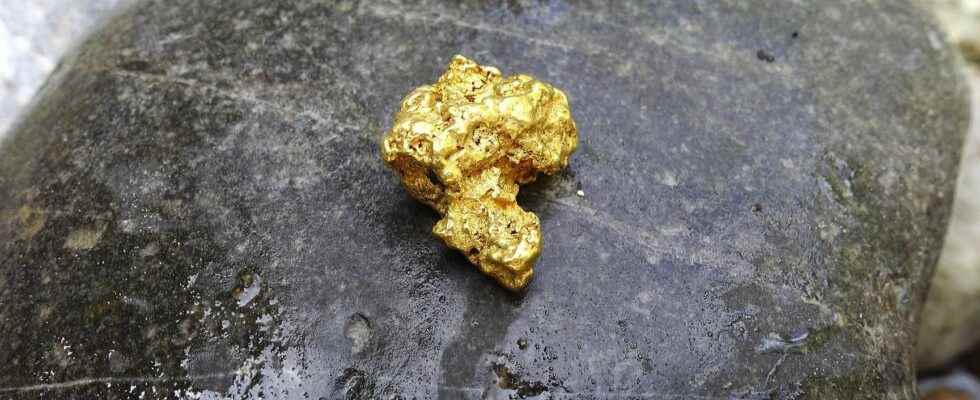Want to discover gold panning and find your own gold flakes and nuggets? No need to travel to the other side of the world to find this precious metal, just get your feet wet in the French rivers! Of course, if you want to make a fortune, France is not the destination indicated, but the gold-bearing rivers are however numerous and can allow you to learn about this practice!
You will also be interested
[EN VIDÉO] Can you turn lead or mercury into gold? Gold is a metal which, in its natural state, is considered rare. But would it be possible to create it artificially from lead or mercury, for example? Unisciel and the University of Lille 1 explored the question during this episode of Kézako.
Gold is a chemical element from the formation of stars and which became concentrated in the inner Earth layers during planetary differentiation. Gold would thus be 98% stored in the earth’s core. It is very rare to find it in the crust, where it is generally present only in trace amounts, except in areas subject to intense fluid circulation. The deposits auriferous are thus distributed very unevenly on the surface of the Earth. They are characterized by gold concentrations a thousand to a million times higher than the rest of the Earth’s crust.
Searching the rivers for gold in France
These accumulations are linked to the circulation of fluids within the rocks of the crust: fluids loaded with sulphides and chlorides have the ability to solubilize gold present in low doses and to transport it to areas where the metal will then precipitate (fractures, flaws) to give rise to gold deposits. Volcanic regions where hydrothermal activity is particularly high are thus areas where the formation of deposits is favoured.
By the action of the tectonic platesthe rocks trapping let’s go of gold can end up at theoutcrop, especially in mountain ranges. Erosion will then gradually detach small particles of gold (nuggets or flakes depending on the size) which will join the waterways. This is how rivers are the most appropriate places in France to pan for gold.
Not all rivers are gold bearing, however. To maximize your chances of finding some flakes, you have to target certain rivers in the The Massif Central, the south (Pyrenees, Alps), Jura or Brittany. A detailed list is available hereknowing that gold panning may be prohibited on certain rivers.
How to identify a good spot?
The Armorican massif, with its very old geological formations and the presence of volcanic rocks, is also the most auriferous region of France. However, the gold is present there in included form, in sandstone for example, making it more difficult to harvest. Thus, the departments where it is easiest to find gold in the rivers are Ardèche, Hérault and Gard. The powerful rivers that cross them erode the Cévennes massif, which is rich in deposits. The center of the Pyrenean chain is also a privileged region where it is possible to find pretty glitter in almost all the rivers.
Be careful though, this does not mean that you will necessarily collect glitter simply by plunging your hand into the sediments of one of these rivers. Some knowledge is required to identify a good spot. Since gold is a heavy mineral with a very high density, it will tend to deposit rapidly in areas where the stream is calmer, that is to say inside the meanders (and not in the external erosive zones) or at the level of traps which will form natural obstacles, such as large stones. The zone located behind the obstacle is in fact protected from the current: a whirlwind and a fall of pressure water which will allow sedimentary particles but also gold flakes to settle and accumulate over time. Similarly, rocks or tree trunkstrees placed on the banks are good gold traps. It will also be necessary to excavate the sediments deposited directly downstream of these objects to maximize its chances of finding the precious metal. In general, any sudden change in the debit of the current is a zone favorable to the deposit of gold. Before taking out your gold panning equipment, it is therefore necessary to closely observe the river in order to identify any variation in flow (downstream of a narrowing or the arrival of a confluence, for example).
On your way!
Summer is also the best season of the year, watercourse being generally calmer and receding, while the floods of thewinter and spring will tend to mobilize sediments and gold particles.
All you have to do is bring the essential accessory for the gold digger: the pan or pan, whose hollow shape will allow the sediments collected on the bottom of the river to be gradually washed away. By applying a movement of rotation, the lighter particles will be expelled at the edges while the heavier gold will concentrate in the hollow part. As the sediments are washed, we can thus see the appearance of small golden sequins. To retrieve them, pipette or a small piece of adhesive tape (to stick on a black sheet to highlight your find) will do the trick!
Interested in what you just read?
